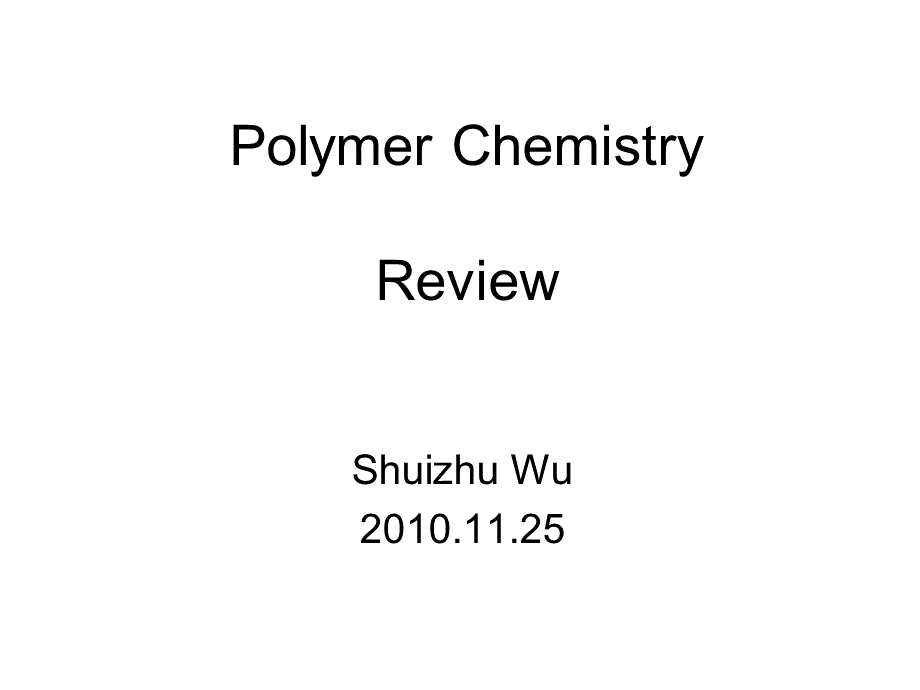华南理工大学高分子化学总复习.ppt
《华南理工大学高分子化学总复习.ppt》由会员分享,可在线阅读,更多相关《华南理工大学高分子化学总复习.ppt(56页珍藏版)》请在冰点文库上搜索。

PolymerChemistryReview,ShuizhuWu2010.11.25,答疑安排:
赵建青25-101吴水珠25-514刘述梅25-317、25-504刘海敏13-204张安强25-53012月3日上午9:
0011:
30下午3:
005:
00(部分),题型,名词解释10分5小题填空12分6小题选择题18分6小题问答题35分7小题计算题25分5小题,Chapter1Introduction,BasicconceptsDP(聚合度):
聚合物的结构单元数(或重复单元数)。
Chainsegment(链节):
结构单元俗称为链节。
homopolymer(均聚物):
由一种单体进行聚合所得的聚合物。
copolymer(共聚物):
由两种或多种单体同时参与聚合所得的聚合物。
thermoplasticpolymer(热塑性聚合物):
热塑性是指一般线型或支链型聚合物具有可反复加热软化或熔化而再成型的性质,具备热塑性的聚合物称作热塑性聚合物。
thermosettingpolymer(热固性聚合物):
热固性是指交联聚合物一次成型后,加热不能再软化或熔化而重新成型的性质,具有这种性质的聚合物称作热固性聚合物。
kineticchainlength(动力学链长):
动力学链长是指每个活性中心自引发至终止平均所消耗的单体分子数,2.Classificationandnomenclatureofpolymers(聚合物的分类和命名)3.Polymerization4.Molecularweightanditsdistribution5.Microstructure6.Linear,branchedandcrosslinkedpolymers7.Aggregatestructure8.Mechanicalproperties.,Keypoints:
Whatsthedifferencebetweenmacromoleculeandlow-molecular-weightcompounds?
highmolecularweight,repeatunit分子量大,由许多相同的结构单元经共价键重复连接而成molecularweightpolydispersityandstructurepolydispersity分子量多分散性和结构多分散性Differentunits有几种运动单元microstructure结构复杂,有一次、二次和三次结构。
一次结构是指大分子链中的结构单元或相邻结构单元的立体排布。
二次结构是指单个分子链的构象或聚集态类型。
三次结构是指高分子聚集体中大分子链的排列情况。
Whatsthedifferencebetweenthermoplasticresinandthermoset?
Thermoplastic:
Becomingsoftwhenheatedandhardwhencooled聚合物具有的可反复加热软化或熔化而再成型的性质Thermoset:
Athermosetmaterialcannotbemeltedandre-shapedafteritiscured交联聚合物一次成型后,加热不能再软化或熔化而重新成型的性质,Howtodistinguishrubber,fiberandplastic?
橡胶分子的柔性大,分子间作用力小;纤维常为结晶性聚合物,分子间作用力大;塑料的分子间作用力介于二者之间。
分子量的计算,其中ni,mi,Mi分别代表i-聚体的分子数、质量和分子量。
MiDPMru,Chapter2Freeradicalpolymerization,Monomerssuitableforradicalpolymerizationmostofthevinylmonomersaresuitableexceptfor1,1-dicyanoethylenenitroethylene2.MechanismofradicalpolymerizationInitiation链引发Propagation链增长Termination链终止chaintransfer链转移,Characteristicsoffreeradicalpolymerization:
Sequenceofevents:
initiation,propagation,termination,chaintransfer基元反应:
链引发、链增长、链终止、链转移Asthereactiontimeisincreased,DP(ormolecularweight)varieslittle.随反应时间的延长,分子量(聚合度)不变Theconversionincreasesasthereactiontimeisincreased.随反应时间的延长,单体浓度逐渐降低,聚合物浓度增加,转化率提高。
Smallamountofretardantcanterminatethepolymerization少量阻聚剂可使聚合终止,3.InitiatorsAzotype脂肪族偶氮化合物AIBNb.Peroxide过氧化物BPOc.Redoxsystems氧化还原体系t1/2=ln2/kd=0.693/kd,比较自由基聚合、阳离子聚合、阴离子聚合Ziegler-Natta聚合所用的引发剂的区别。
自由基聚合:
易分解形成自由基的化合物阳离子聚合:
一般为Lewis酸类化合物阴离子聚合:
一般为Lewis碱类化合物Ziegler-Natta聚合:
主引发剂为Lewis酸类化合物,共引发剂为Lewis碱类化合物,但它不是阳离子聚合和阴离子聚合引发剂的简单加合。
Rateofinitiation:
Ri=kdIInitiatorefficiencyf:
thefractionofradicalsformedintheprimarystepofinitiatordecompositionwhicharesuccessfulininitiatingpolymerization.引发聚合部分的引发剂占引发剂分解或消耗总量的分率,InitiatorefficiencyTheinduceddecompositionofinitiator引发剂的诱导分解,徒然消耗引发剂,降低引发剂效率Thepresenceofsolvent(ormonomer)cagewhichtrapstheradicalsforsomeperiodbeforetheydiffuseapart笼蔽效应andothersidereactions其他副反应,4.KineticsoffreeradicalpolymerizationThreeassumptions:
A.KPandKtareindependentofthesizeoftheradical,namelyequivalenceofreactivityforpropagatingchainradicals等活性假定,链自由基的活性与链长无关B.Steady-stateassumption:
theconcentrationofradicalsincreasesinitially,butalmostinstantaneouslyreachesaconstant,steady-statevalue.Ri=Rt稳态假设C.highDP,theamountofmonomersusedforinitiationisfarlessthanthatforpropagation,RiRP聚合度很大,Polymerizationrateexpression:
Autoacceleration:
Asthepolymerizationproceedstheviscosityofthesystemincreasesandterminationbecomesincreasinglyslower.Highviscosityaffectsterminationmuchmorethanpropagation.Therefore,thequantitykP/kt1/2increases,theresultisanincreaseinRPandmolecularweight.自动加速效应的本质:
双基终止,DPandmolecularweighttheaveragenumberofmonomermoleculesconsumed(polymerized)pereachradicalwhichinitiatesapolymerizationchain.每个活性种从引发阶段到终止阶段所消耗的单体分子数。
1/DP=1/DP0+CTT/M1/Xn=1/Xn0+CTT/M(存在链转移反应)ChaintransferreactionsVinylchlorideDPdependsonT通用聚氯乙烯的聚合度一般仅由温度来控制,聚合速率或时间则由引发剂浓度来调节。
InhibitionandretardationInhibitorsstopeveryradicalandpolymerizationiscompletelyhalteduntiltheyareconsumed.阻聚使反应停止Retardersarelessefficientandstoponlyaportionoftheradicals.缓聚使反应速率减小,5.ThermodynamicsEquilibriummonomerconcentrationTheceilingtemperatureatwhichthepropagationanddepropagationratesareequal.Uppertemperaturelimitabovewhichpolymercannotbeobtainedevenfrompuremonomer.Theceilingtemperature(当Me=1M时,聚合和解聚处于平衡状态的平衡温度)聚合上限温度,Chapter3Chaincopolymerization,Typesofcopolymers:
Statistical(Random)无规Block嵌段Graft接枝Alternating交替,2.CopolymerizationequationReactivityratios竞聚率是均聚增长和共聚增长的速率常数的比值,Copolymerequation,3.Typesofcopolymerizationbehavior以下各竞聚率的含义是什么?
r1=0自由基1不能与同种单体均聚,只能共聚r1=1自由基1加成同种或异种单体的难易程度相同,均聚和共聚的高铝相同r11自由基1容易进行均聚r1=自由基1不能共聚,只能均聚,idealcopolymerizationr1r2=1r1r2=1,共聚物组成与单体组成相等Alternatingcopolymerization:
r1=r2=0r11,r21,r21),4.Reactivitiesofmonomerandradical会利用竞聚率判断单体、自由基的相对活性(注意同一参照物)r1=0.3,r2=1.5:
活性M1M25.EffectsofsubstituentsonthereactivitiesofmonomerandradicalResonanceeffectTheorderofmonomerreactivitiescorrespondstotheorderofincreasedresonancestabilizationbytheparticularsubstituentoftheradicalformedfromthemonomer.,Theorderofsubstituentsinenhancingradicalreactivityistheoppositeoftheirorderinenhancingmonomerreactivity.PolareffectsResonanceeffectspolareffects取代基对自由基活性的影响比对单体活性的影响要大得多。
6.Q-eschemeQdescribestheresonancefactoredescribesthepolarfactor(吸电子基团,正值)IdealcopolymerizationoccursbetweentwomonomershavingsimilarQandevalues,forexample,styrene-1,3-butadiene,vinylchloride-vinylacetate,andacrylonitrile-methylacrylate.ThetendencytowardalternationisgreatestformonomershavingsimilarQvalueswithhighevaluesofoppositesign,e.g.styreneandmaleicanhydride,Chapter4PolymerizationProcesses,ComparisonoffourpolymerizationmethodsAsidefromthephysicaldifferencebetweentheemulsionandotherpolymerizationprocesses,thereisoneverysignificantkineticdifference:
bothhighmolecularweightsandhighreactionratescanbesimultaneouslyattained,本体聚合:
定义,特征溶液聚合:
定义,特征悬浮聚合:
定义,特征乳液聚合:
定义,特征乳液聚合的组成,规律?
Chapter5Ionicpolymerization,Cationicpolymerizationislimitedtothosemonomerswithelectron-releasingsubstituentssuchasalkoxy,phenyl,vinyland1,1-dialkylforexample,butylene,alkoxyalkene,conjugatedalkeneAnionicpolymerizationtakesplacewithmonomerspossessingelectro-withdrawinggroupssuchasnitrile,carboxyl,phenyl,andvinyl共轭烯烃类单体可进行自由基、阳离子、阴离子聚合,会判断哪些单体能进行自由基、阳离子、阴离子聚合根据反应条件中给出的引发剂种类即能判断聚合反应是自由基、阳离子或阴离子聚合Cationicpolymerization:
Lewis酸LewisacidAnionicpolymerization:
Lewis碱(alkalimetal,metalalkyl),Livinganionicpolymerizationwhyanionicpolymerizationcanbe“living”?
活性聚合物是指在链增长反应中,活性链直到单体全部耗尽仍保持活性的聚合物,再加入单体还可继续引发聚合,聚合的分子量继续增加。
在阴离子聚合反应中,带有相同电荷的活性链离子不能发生双基终止;活性链负碳离子的反离子常为金属离子,它一般不能夺取链中的某个原子或H+而终止;活性链通过脱去H-离子发生链终止又很困难,所以当体系中无引起链转移或链终止的杂质时,实际上是无终止聚合,即活性聚合。
Whyautoaccelerationwillnotoccurinionicpolymerization?
活性增长种带电荷,同种电荷相斥,因此无双基终止,不会发生自动加速效应whytherateofanionicpolymerizationislargerthanthatofradicalpolymerization?
活性增长种的浓度高;无终止。
离子对增长种的结合形式及其活性Innon-polarsolvents,extensiveassociationtakesplaceathighbutyllithiumconcentrations,theinitiationandpropagationratesarefoundtobeproportionaltoonlythe1/6and1/2powersofbutyllithiumconcentrationrespectively.Thisresulthasbeeninterpretedintermsoftheassociationequilibriawiththeinitiatorandpropagatingionpairsinequilibriawiththecorrespondinghexameranddimer,会判断阴离子活性聚合用于制备嵌段共聚物时的单体加料顺序(从单体结构判断)Distinguishingbetweenradical,cationic,andanionicpolymerizations如分子量和聚合时间的关系、引发剂、转化率和聚合时间的关系等,Ring-openingpolymerization环状单体在引发剂作用下形成线型聚合物的过程。
Polymerizability(容易开环聚合的程度):
3,487,5开环聚合的性质?
Chapter6Coordinationpolymerization,CompositionofZiegler-Nattacatalysts(Ziegler-Natta催化剂的组成)Ziegler-Nattacatalystsareusuallycomposedofmaincatalystandco-catalyst:
CompoundsofGroupIV-VIIItransitionmetal:
(主引发剂是IV-VIII族过渡金属化合物)Co-catalyst:
GroupI-IIIorganometalliccompounds(共引发剂I-III族有机金属化合物),Ziegler-Nattacatalysts:
Lewis酸和Lewis碱,但不是简单的加合,而是能使单体通过配位聚合形成立构规整的聚合物,Polypropylene配位聚合的意义,典型催化剂Polyethylene分类,典型催化剂,能判断给出的单体能否进行配位聚合能形成哪些立构规整聚合物是否具有旋光活性,Chapter7Steppolymerization,Characteristics:
特征Disappearanceofmonomerveryearlyinthereactionfarbeforetheproductionofanypolymerofsufficientlyhighmolecularweighttobeofpracticalutility.(单体在反应初期迅速消失,但聚合物的分子量需要较长时间才能达到满足应用的要求)Anytwospeciesinthereactionmixturecanreactwitheachother.(在反应体系中任何两个物种均可互相反应)Polymerizationrateisthesumoftheratesofreactionbetweenmoleculesofvarioussizes.(聚合速率是不同大小的物种之间互相反应的速率之和),Controlofmolecularweightisimportantinlinearcondensationpolymerization.(分子量控制是线形缩聚的关键)Controlofgelpointisimportantincrosslinkedcondensationpolymerstructure.(凝胶点的控制是体形缩聚的关键),会判断给出的单体对能否缩聚成为高聚物(成环)Thegeneralorderofthermodynamicstabilityofdifferentsizedringstructuresis:
(不同大小的环结构的热力学稳定性顺序如下)n=3,4,8to117,12andlarger5,6自由基聚合和逐步聚合的比较如转化率、分子量等,ForthepolymerizationofthebifunctionalmonomersaAaandbBb(e.g,diolanddiacidordiamineanddiacid),thenumbersofaandbfunctionalgroupsaregivenbyNaandNbrespectively.(二元酸aAa和二元醇bBb进行缩聚,设Na和Nb为a、b的起始基团数,分别为两种单体分子数的2倍)r=Na/Nbr1,aAaplusbBbpolymerization(stoichiometricbalance)withtheadditionofsmallamountsofamonofunctionalreactantCb.(aAa和bBb两种单体等基团数,另加微量单官能团物质Cb),PolymerizationofaRbtypemonomers(internallysuppliedstoichiometry)withtheadditionofsmallamountsofmonofunctionalmonomerCb.(aRb加少量单官能团物质Cb),注意Xn和DP的区别:
如己二酸和已二胺的缩聚物(2DP),11-氨基十一羧酸的缩聚物注意从题目中给出的说明判断已知条件:
如可能制得的最大聚合度是多少?
CrosslinkingincondensationpolymerizationAveragefunctionality平均官能度Predictionofgelpoints凝胶点的预测CarothersEquation(Carothers方程),Statisticalapproachtogelation统计法TheratioofallAgroups,bothreactedandunreacted,whicharepartofbranchuni